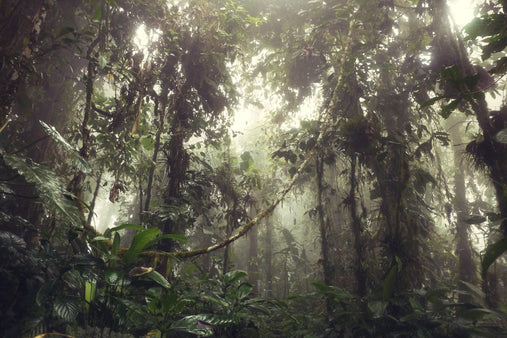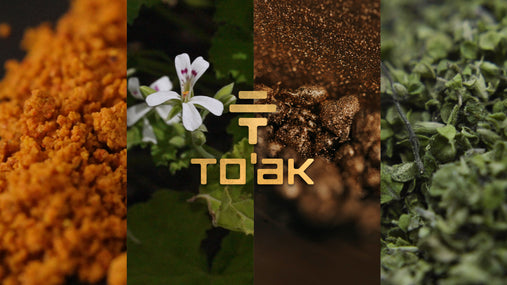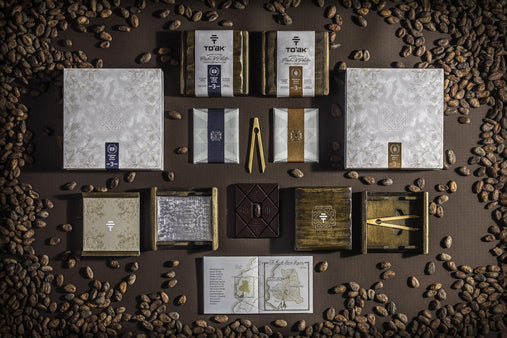
20th of May 2018
The very first step of the chocolate-making process precedes activities like harvest and fermentation. And it certainly precedes anything that goes on in the factory. It all starts with cultivating the cacao tree itself.
Many very good chocolate makers live thousands of kilometers (or miles) from the nearest cacao tree and don’t have the privilege of working with cacao on the land. This is a limitation. I believe the best way to truly understand cacao is to live with the trees, to raise them from seed, like babies, and tend to them over their course of their lives.
"Of all the steps required to make chocolate, the cultivation of cacao trees is the part I know the best and that I enjoy the most."
Of all the steps required to make chocolate, the cultivation of cacao trees is the part I know the best and that I enjoy the most. I’ve been cultivating cacao trees in Ecuador for over a decade by now, which is nothing compared to some of my veteran colleagues in Piedra de Plata, who’ve been doing it for over fifty years. But a decade of this life has at least offered me enough experience to describe this process to other people who may be interested in learning more about it. And rather than wax eloquent on how cacao farming in Ecuador is akin to viticulture in Burgundy—as I am prone to do—I will simply dive into the particulars.
It starts with looking for a cacao tree that exhibits certain characteristics that you wish to reproduce. The main things you look for are health and vigor, flavor, yield, and—most importantly, in my opinion—the variety. I admit to being stridently loyal to Nacional, for reasons that are well-publicized. In another blog post, I will explain those reasons in detail. For now, let’s get back to the trees.
Choosing the Mother Tree
First, you choose a tree that you want to reproduce. Maybe you choose a top-performing tree in your own farm. Or maybe you scope out trees on your neighbor’s land. If the tree that you want to reproduce is on someone else’s land, etiquette obliges you to ask permission to harvest a pod for seed.
As long as you are in good standing with your neighbor, permission will be granted. In exchange, it is customary to share some seeds from your own farm—be it cacao or some other fruit tree. I’ve recently been using seeds from one of my biriba trees (Rollinia deliciosa) as trade fodder—the biriba is a hidden gem in the tropical fruit world.
 Pods growing on the trunk are fine for chocolate but not for seed—local wisdom that is not corroborated nor refuted by science.
Pods growing on the trunk are fine for chocolate but not for seed—local wisdom that is not corroborated nor refuted by science.
Harvesting Seed
There is an interesting detail about which part of the cacao tree the pod should be harvested from, in pursuit of seed to plant. One of the peculiarities of the cacao tree is that it produces flowers (and subsequently fruit) along its trunk as well as from its branches. The scientific term for this unique type of tree is “cauliflory”. If you talk to farmers in Piedra de Plata or in the community nearest to the cacao plantations that I manage, or in most any other cacao-growing community around here, they’ll tell you that the best pods to use for seed are those that grow on branches as opposed to the trunk.
For making chocolate, pods on both trunk and branches are equally fine. But they say that pods harvested from the trunk aren’t good for seed, because they produce low-yielding trees—and they swear by this. I’ve never seen any scientific evidence that supports or refutes this claim, and I’ve never fully believed it, but I still adhere to it just in case it’s true.
"The only way to ensure the genetics of a cacao seedling is to graft it with a cutting from a tree you wish to identically reproduce."
You take a machete and slice open the pod. There will be about 30 or so seeds inside—each of them coated in a sweet white pulp. If there are less than 30 seeds or so, or if the seeds are unusually small, you probably shouldn’t plant them. And even if the seeds are numerous and good size, this is no guarantee that they will produce trees that ultimately produce pods with these same characteristics.
The Grafting Option
Cacao trees, like apples and mangos and grape vines and many other species of fruit, don’t grow “true to seed,” owing to the complexities of cross-pollination. The only way to ensure the genetics of a cacao seedling is to graft it with a cutting from a tree you wish to identically reproduce. A tree that has been successfully grafted is technically called a clone. The same principle applies to the wine world. Pinot Noir vines aren’t grown from seed; they’re clones that have been grafted from other Pinor Noir vines.
This is how we're reproducing the DNA-verified 100% pure Nacional trees from Piedra de Plata. We’re trying to preserve an endangered heirloom cacao variety before it goes extinct.
Grafting has a few advantages over growing trees from seed.
-
The tree is ultimately produces will have the same genetic characteristics as the tree from which the graft (i.e., budwood or scion) was taking from.
-
A grafted tree can start producing pods within the first two years of its life, whereas a tree planted from seed usually needs about four years.
-
Grafted cacao trees grow horizontally, whereas cacao trees grown from seed to grow vertically. The horizontal structure of grafted trees is easier to manage and harvest.
 The seeds of the cacao fruit (Nacional from Piedra de Plata). If you plant them, they become trees. If you ferment, dry, and roast them, they become chocolate.
The seeds of the cacao fruit (Nacional from Piedra de Plata). If you plant them, they become trees. If you ferment, dry, and roast them, they become chocolate.
Cloning vs Cross-Pollination
Despite the many benefits of grafting cacao trees, I don’t think this reproductive method should always be done in all circumstances. There is a reason that nature devised the system of cross-pollination, which is basically the same system that humans use for sexual reproduction—a man and a woman have sex together and combine their genes into a unique admixture, which is their child. Traditionally this is how all cacao trees were propagated. This only started to change in the last century—in some cases for better and other cases for worse.
For example, the dreaded high-yield cacao variety known as CCN-51 is a clone. In addition to being the native origin of Nacional cacao, Ecuador is also the origin of CCN-51. But the difference is that Nacional has over 5,300 years of history in Ecuador, whereas CCN-51 was created by an Ecuadorian agronomist in 1965. Now CNN-51 is being reproduced throughout the tropics because of its spectacular productivity, despite its famously poor flavor.
Eventually an opportunistic plant disease will develop the means to decimate CCN-51 throughout the world, similar to what has happened (is happening) to the Cavendish banana. Then there will be a global shortage of cacao, which equates to a shortage of chocolate, and everyone will suddenly be alarmed and point fingers. But that’s what happens when many billions of people demand cheap chocolate. It’s the world we have created for ourselves.
 CCN-51 cacao—taking over the world with its disappointing flavor profile. Photo courtesy of Amazon Cacao.
CCN-51 cacao—taking over the world with its disappointing flavor profile. Photo courtesy of Amazon Cacao.
Getting down to it
I realize that I will need to limit these digressions if we want to get through this article in a timely fashion. In any event, in this account we’re going to grow a tree from seed that has been open-pollinated.
At this point, it’s important to note that “cacao beans” are actually just cacao seeds. If you want to make chocolate, then you remove the sweet pulp-encased seeds from the pod and ferment them, dry them, and roast and grind and refine them and mix them with sugar, etc. That’s how you make chocolate. Or, you can take those juicy cacao seeds and put them into the ground and create a tree.
The thing about planting cacao seeds is that you have to do it within a few days of harvesting the pod. The seeds lose their viability very quickly. But the good thing is that the seeds germinate very readily. Sometimes they even germinate in the pod itself. If so, you definitely don’t want to use those seeds to make chocolate. Chocolate produced from germinated seeds will be astringent and overpoweringly vegetal. The best thing to do with seeds like that is simply plant them.
 Five week old Nacional cacao seedlings from Piedra de Plata in our tree nursery.
Five week old Nacional cacao seedlings from Piedra de Plata in our tree nursery.
Prepping for Germination
I’ve read several PDFs and technical manuals about clever ways to prepare cacao seeds for planting—for example, using sawdust to strip the pulp from the seed. This is interesting, and I’m sure it works, but I don’t see the point in going to all of that trouble. In my experience, about 80% of cacao seeds germinate without any special treatment. With a mere fifteen cacao pods, you can produce 400 cacao trees, so increasing the germination rate by a few percentage points has never been a top priority for me.
This calls to mind yet another tactic recommended by old-school farmers, which is to only plant the seeds from the middle of the pod. The seeds on the ends of the pod look like runts and don’t inspire as much faith as the larger seeds in the middle. Again, I haven’t seen the scientific data to justify this technique, but it seems like sound advice and I’ve always followed this prescription.
"Despite the fact that chocolate is a multi-billion-dollar business, the science of cacao farming is still not fully developed."
Agronomy vs Traditional Methods
Despite the fact that chocolate is a multi-billion-dollar business, the science of cacao farming is still not fully developed, and there continues to exist a good deal of conflicting information on proper technique. In the world of Ecuadorian cacao farming, I’ve found value on both sides of the information spectrum.On the one side of the spectrum you have the traditional methods used by old-school farmers, passed down from fathers and grandfathers and great grandfathers.
On the other side you have the more technical methods preached by the professional agronomists. Both approaches have their benefits and drawbacks. The methods I describe here draw from both sources. The modern technical methods are most helpful in the areas of pruning and fertilization, but when it comes to germinating seeds and transplanting them into the field, the old-school farming methods work just fine.
Organic vs Chemical
Another point worth mentioning is that everything I describe here, and anywhere else, conforms to certified organic standards. There’s a lot of chemical agriculture in Ecuador, but most old-school cacao farmers follow organic methods regardless of whether or not they go through the bureaucratically exhaustive certification process. And the reason for this is not due to ecological concerns, but simply because chemical inputs are not needed to successfully cultivate cacao.
Cacao is one of those fruit trees that lends itself very well to organic cultivation, so long as it’s grown in a relatively diverse agroforestry setting, which is typically how Nacional cacao is grown. CCN-51, on the other hand, is primarily grown in monocultures and, as a result, is often dependent on chemical inputs. I don’t mean to keep dumping on CCN-51, I’m merely stating the facts, at least as far as Ecuadorian cacao farming. I can’t speak for other countries but I suspect that the situation is similar.
"Cacao is one of those fruit trees that lends itself very well to organic cultivation, so long as it’s grown in a relatively diverse agroforestry setting, which is typically how Nacional cacao is grown."
Giving birth
The way that I prefer to germinate cacao seeds is simply by sewing them in a germination bed in a tree nursery. In the Jama-Coaque Reserve, our tree nurseries tend to be fairly informal. I usually just dig up a long corridor of soil in a partially-shaded section of our production zone. Then I lightly amend the soil (which is naturally clayey) with a bit of compost that we produce from kitchen scraps. I mark the perimeter of the bed with bamboo trunks, and plant the seeds into the soil. Then I usually place a tagua palm frond on top of the soil at least for the first two weeks, to further protect it from direct sunlight.
Now the task is to keep the soil moist at all times. Not wet, just moist. This requires daily attention—sometimes twice-daily. After several weeks, you start to see a bud peeking its head above the surface of the soil. This is the first step on the long road to making chocolate.

100% pure Nacional cacao seedling planted in the Jama-Coaque Reserve in April, 2018.
Featured products
More from us


